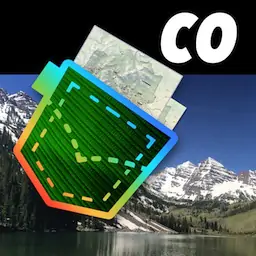by Alex Gugel , all rights reserved
Canyon Rim and Window Rock TrailsColorado National Monument |
Brochure about the Canyon Rim and Window Rock Trails at Colorado National Monument (NM) in Colorado. Published by the National Park Service (NPS).
featured in
| National Parks Pocket Maps |  | |
| Colorado Pocket Maps |  |
Colorado
National Park Service
U.S. Department of the Interior
National Monument
Colorado National Monument
Fruita, Colorado
Canyon Rim and Window Rock Trails
Otto’s Trail
Monument
Canyon
The Island
Independence
Monument
Praying Hands
Pipe Organ
Wedding Canyon
This hike along Canyon Rim Trail (1/2 mile one-way) leading to Window Rock Trail (1/4
mile one-way) provides an excellent introduction to the natural wonders of Colorado
National Monument. Bold, big, and brilliantly colored, the steep-walled canyons and
towering masses of naturally sculpted rock found here provide inspiration to hundreds of
thousands of visitors each year.
Beginning from the back porch of the Visitor Center, hike along the Canyon Rim Trail
to the Bookcliff Overlook and continue on the adjoining Window Rock Trail. Both trails
wind along the cliff edge with views of large, towering rock formations. It takes 30-45
minutes to walk both trails and return to the Visitor Center. Use the map on the reverse of
this page for guidance.
Geology
The Canyon Rim and Window Rock Trails
are situated on the Kayenta Sandstone Formation. This sandstone is more resistant
to erosion than the formations above and
below it so it forms ledges. The concave
“smile” shaped layers seen along the trail
are ancient stream channels. At the time
these rocks were deposited, the climate
was much different than today, rainfall became more abundant and shallow streams
flowed across the area.
As you look south into Wedding and Monument Canyons, you will see large concentrations of freestanding rock formations
called monoliths. These towering rock
monoliths have descriptive names such as
Flora
The dominate lifezone here is the PinyonJuniper Woodland - A plant community
found throughout the Colorado Plateau
between the elevations of 4,500 and 6,500
feet. The pinyon-juniper woodland consists of dwarfed, deep rooted, evenly
spaced pinyon pine and Utah juniper
trees separated by open areas with sparse
vegetation: a landscape referred to as the
pygmy forest.
The pinyon pine has short needles
grouped in bundles of two and small cones
bearing large, edible seeds. Drought usually limits the tree’s growth to heights of
thirty feet or less, giving the tree a stunted
appearance.
the Praying Hands, Pipe Organ, Kissing
Couple and Independence Monument (see
above photo). Monoliths are the most dramatic rock features of the Colorado National Monument, resulting from differing
rates of weathering and erosion in adjacent
layers of hard and soft rock.
In the distance, on the north side of the
valley, the Bookcliffs rise from the floor of
the Grand Valley to make the north boundary of the valley all the way to Price, Utah.
The arid sands of the Mesa Verde Formation form the protective cap layer that
supports the steep, easily weathered soft
Mancos Shale slopes from eroding away.
Like living sculpture, the gnarled form of
Utah juniper is the other common evergreen in Colorado National Monument.
The frosty blue berries of the Utah juniper
are actually modified cones in which the
seeds are encapsulated in a waxy, hard
shell. The Utah juniper leaves appear as
tiny overlapping scales along the branches,
giving the tree a distinctive appearance.
Among the trees in the pinyon-juniper
woodland are smatterings of cacti, yucca,
grasses and semidesert shrubs such as
cliffrose, Mormon tea, big sagebrush, rabbitbrush and mountain mahogany. This
vegetation provides food and shelter for
animals living in the Monument.
Civilian Conservation
Corps (CCC).
Conclusion
After establishing of Colorado National
Monument in 1916, this area was accessible
only by foot or horseback for many years.
The Civilian Conservation Corps (CCC)
was created in 1933 during America’s worst
depression and dissolved in 1942. Across
the nation from 1933 to 1942, approximately three million young men worked for
various CCC projects. In 1933, Company
824 of the CCC and National Park Service
employees built Camp NM-2-C near the
present site of the Visitor Center (see above
photo). Nothing remains of these buildings today, but see if you can determine
their location using the picture and the
clues it contains.
We hope you enjoyed your hike along the
Canyon Rim and Window Rock Trails.
Perhaps you saw lizards, heard the call of a
red-tailed hawk or smelled the crispness of
sage.
While Canyon Rim and Window Rock Trail
offers many opportunities for stillness and
solitude, they also offer a chance to reflect
on the extraordinary examples of erosion
seen here in Colorado National Monument.
Canyon Rim and Window
Rock Trails/Saddlehorn
Campground
EXPERIENCE YOUR AMERICA
The CCC worked in Colorado National
Monument alongside Local Experienced
Men (LEMs) and National Park Service
employees to build the scenic Rim Rock
Drive which included rock blasting, trail
making, fencing and building structures.
Some of the handiwork of Company 824
can still be seen today – along Rim Rock
Drive, the Window Rock Trail and the
caretaker’s residency near the present day
Visitor Center.


